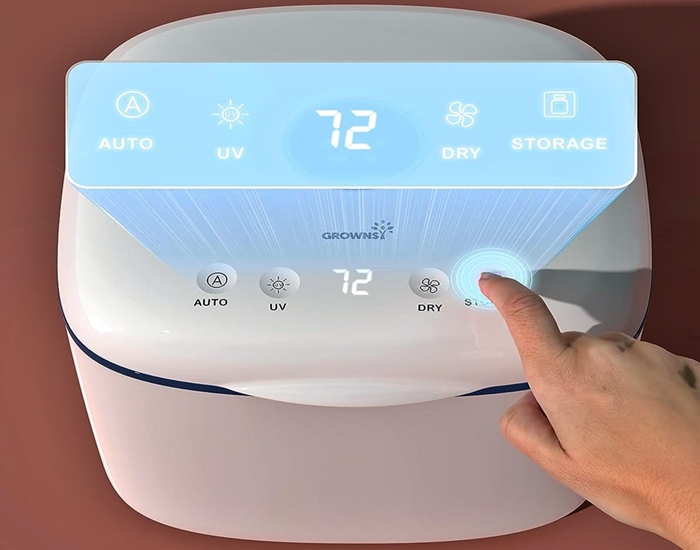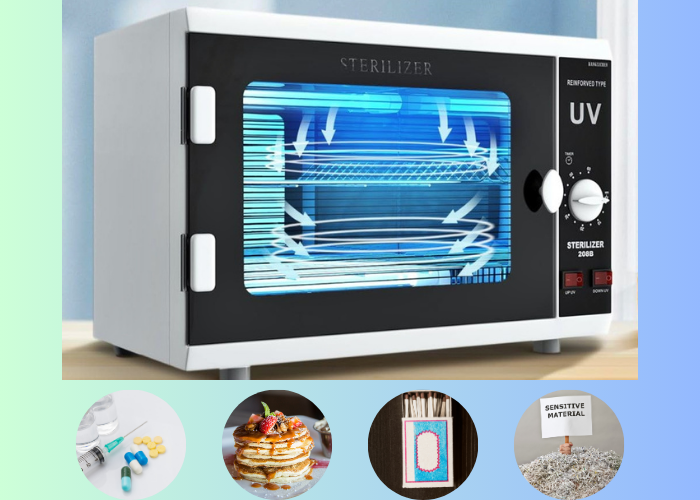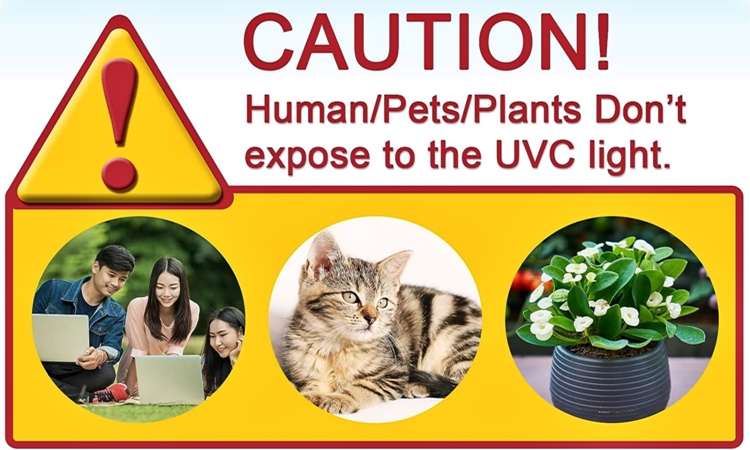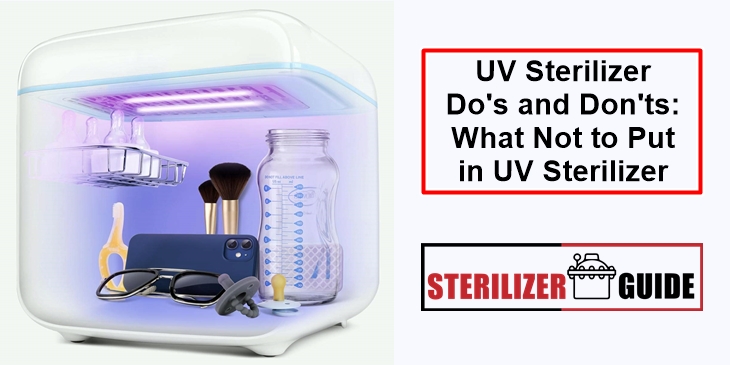UV sterilizers are a vital tool in maintaining cleanliness and hygiene in various settings, from homes to healthcare facilities. These devices use ultraviolet (UV) light to effectively eliminate harmful microorganisms, ensuring the safety of the items we use daily.
To harness the full potential of UV sterilization while keeping safety a top priority. It’s crucial to know what you should and shouldn’t put in them. In this article, we’ll provide practical guidance on what not to put in UV sterilizer and what to put.
Understanding UV Sterilizers

Ever wondered how UV sterilizers work their magic? We’ll break it down for you. These devices use ultraviolet (UV) light to kill germs and bacteria on various items.
Our Recommedded UV Sterilizer: GROWNSY UV Light Sanitizer, 4-in-1 Bottle and Household Sterilizer
Picture it as a mini sun in a box, without the scorching heat. UV sterilizers are like superheroes in the fight against invisible nasties. They’re used in homes, healthcare settings, and industries to ensure everything stays germ-free.
What Not to Put in UV Sterilizer

While UV sterilizers are incredibly versatile and effective, certain items should never find their way into these devices. Whether it’s due to potential damage or safety concerns, it’s essential to exercise caution and discretion when deciding what to place inside your UV sterilizer. Here’s a comprehensive list of items to keep out:
Sensitive Electronics: Electronics such as smartphones, tablets, or any devices with LCD screens should be kept far away from the UV sterilizer. The intense UV-C light can harm these delicate components, potentially causing irreparable damage.
Heat-Sensitive Materials: Materials that are prone to melting or warping under high temperatures, especially plastic items, should never be subjected to UV sterilization. Protect these items from potential distortion by choosing alternative cleaning methods.
Reflective Surfaces: Objects with highly reflective surfaces, such as mirrors or shiny metal items, should be excluded from UV sterilization. The reflective nature of these surfaces can hinder the UV light’s ability to reach all areas, compromising the sterilization process.
Medications and Supplements: UV light has the potential to degrade the effectiveness of certain medications and supplements. To ensure their potency and safety, always adhere to specific storage instructions provided for these items, rather than attempting UV sterilization.
Food and Consumables: It’s essential to understand that UV sterilization is not suitable for food or consumable items. Avoid placing edibles, liquids, or anything meant for consumption inside the UV sterilizer. Instead, use approved methods for cleaning and sanitizing such items.
Flammable Materials: Items that are flammable or combustible, such as aerosol cans or alcohol-based products, should never be introduced to UV sterilizers. UV-C light generates heat, and exposure to flammable substances can lead to safety hazards.
Wet or Damp Items: UV sterilizers typically work best with dry items. Avoid placing wet or damp items inside, as moisture can affect the device’s efficiency and potentially lead to electrical hazards.
By steering clear of these items and following these guidelines, you can maximize the benefits of your UV sterilizer while safeguarding your possessions and promoting overall safety.
What to Safely Sterilize with UV Sterilizers

Maintaining a clean and hygienic environment is a top priority in today’s world. UV sterilizers have emerged as powerful allies in this quest for cleanliness, offering an effective way to rid items of harmful pathogens. Whether you’re a parent concerned about your child’s well-being or someone who values personal hygiene, UV sterilization can play a crucial role. Here’s a look at what you can safely sterilize using UV sterilizers:
Baby Bottles and Pacifiers:UV sterilizers are excellent at sterilizing baby bottles, nipples, and pacifiers. They ensure your child’s feeding equipment is free from harmful pathogens, creating a safe environment.
Toothbrushes: Regular UV sterilization of toothbrushes is a simple and effective way to prevent harmful bacteria and germs. Dental hygiene is non-negotiable, and this practice helps maintain it.
Personal Protective Equipment (PPE): During illness outbreaks or when hygiene concerns are high, UV sterilization is a trusted way to disinfect items like masks, gloves, and goggles. It provides an extra layer of protection for your safety.
Kitchen Utensils: A UV sterilizer effortlessly sanitizes small kitchen items like utensils, cutting boards, and reusable food containers. This ensures a safe environment for preparing and serving your food.
Beauty Tools: Tweezers, nail clippers, and makeup brushes are essential elements of personal grooming. UV sterilization elevates your beauty routine by ensuring these tools remain safe and hygienic for use.
Children’s Toys: Children’s toys often come into contact with various surfaces and are prone to germs. UV sterilization can help keep your child’s toys clean and free from harmful pathogens.
Electronics Accessories: You can safely sterilize items like earphones, headphones, and chargers using UV sterilizers. This helps keep your daily accessories free from bacteria.
Jewelry: You can easily maintain the cleanliness of your Jewelry items like; rings, earrings, and bracelets by sanitizing them with UV sterilizers. This helps keep your accessories free from germs and bacteria.
Eyeglasses and Sunglasses: Keeping eye-wear clean is essential for both clarity and hygiene. UV sterilization can effectively disinfect your glasses without risking damage.
Before placing any of these items in the UV sterilizer, it’s crucial to clean and thoroughly dry them. Additionally, always adhere to the manufacturer’s instructions regarding proper positioning and settings to achieve optimal results.
Safety and Health Considerations

Prioritize safety and health when using UV sterilizers. Prolonged exposure to UV-C light can be harmful to the skin and eyes. Always ensure that the UV sterilizer’s safety features are intact, and never look directly at the UV light source during operation. Here are some key considerations to keep in mind:
UV-C Light Exposure: Prolonged exposure to UV-C light can be harmful to the skin and eyes. Exercise caution and avoid direct exposure whenever the UV sterilizer is in operation.
Check Safety Features: Always ensure that the UV sterilizer’s safety features are intact and functioning correctly. This includes features like automatic shut-off mechanisms and childproof locks.
Avoid Direct Gaze: Never look directly at the UV light source when the sterilizer is in operation. Use appropriate protective eye-wear if necessary.
Child Safety: Keep UV sterilizers out of the reach of children. These devices can pose risks to curious young ones, so ensure they cannot access or tamper with them.
Proper Ventilation: Use UV sterilizers in well-ventilated areas to prevent the accumulation of ozone, which may be produced during the sterilization process.
Follow User Manual: Always refer to the manufacturer’s user manual for specific safety guidelines and usage instructions for your UV sterilizer model.
By following these safety and health considerations, you can ensure that your use of UV sterilizers is both effective and safe, promoting a clean and secure environment for yourself and your loved ones.
Tips for UV Sterilizer Maintenance
Maintaining the effectiveness and longevity of your UV sterilizer is vital to ensure it continues to serve as a reliable tool for maintaining cleanliness and hygiene. Proper maintenance not only keeps your sterilizer in optimal working condition but also extends its lifespan. Here are some practical tips to help you maintain your UV sterilizer effectively:
Regularly clean the sterilizer’s interior: Over time, dust and residue can accumulate inside the sterilizer, potentially reducing the effectiveness of the UV light. Regular cleaning helps ensure that the sterilizer operates at its full potential.
Replace UV bulbs as recommended: UV sterilizers rely on specialized UV bulbs to produce the necessary UV-C light for disinfection. It’s essential to replace these bulbs according to the manufacturer’s recommendations to maintain the device’s efficiency.
Store the device in a cool, dry place: When your UV sterilizer is not in use, store it in a cool, dry location. This helps prevent unnecessary wear and tear on the device and ensures it remains in good working condition when you need it.
Refer to the manufacturer’s maintenance guidelines: Each UV sterilizer model may have unique maintenance requirements. To ensure you’re following the right procedures, refer to the manufacturer’s maintenance guidelines specific to your device. These guidelines often provide detailed instructions on cleaning, bulb replacement, and other essential maintenance tasks.
To maintain the effectiveness and reliability of your UV sterilizer, simply follow these practical maintenance tips. This will help ensure that it continues to provide a clean and safe environment for all your sterilization needs.
Wrapping Up!
From safeguarding your child’s feeding equipment to upkeeping personal items, UV sterilizers offer versatility and efficiency. Nonetheless, exercise caution, especially with sensitive materials and electronics, and adhere closely to manufacturer instructions.
Prioritizing safety and health is paramount. Always respect the potential risks of prolonged UV-C light exposure and keep UV sterilizers away from children’s reach. Should you have questions or need guidance, consult the manufacturer’s guidelines or seek assistance. Here’s to a healthier, more hygienic lifestyle, all thanks to the incredible capabilities of UV sterilization!

